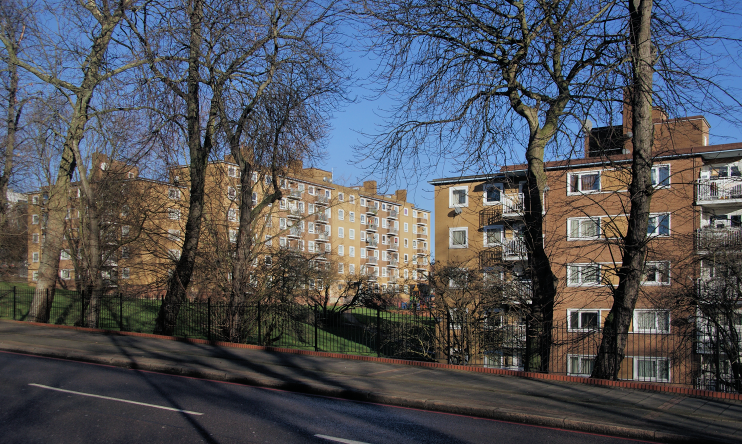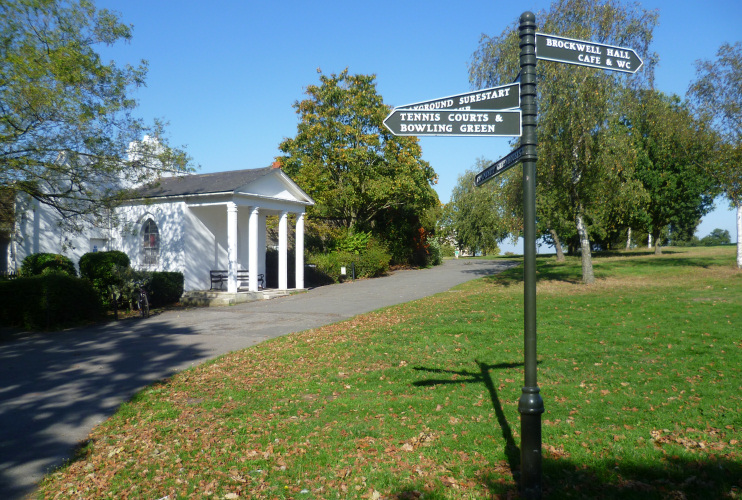Tulse Hill
Tulse Hill, Lambeth
A socially disadvantaged locality situated on the south-eastern edge of Brixton, graced by a popular park

Three estates, Bodley, Upgrove and Scarlettes were united in 1352 under the ownership of the hospital of St Thomas the Martyr, an Augustinian priory then located in Southwark. Henry VIII seized the property at the dissolution of the monasteries and by 1563 a house called Brockalle was in existence, near the present junction of Norwood Road and Rosendale Roads. In 1656 the estate was in the hands of the Tulse family. Sir Henry Tulse was lord mayor of London in 1683–4 and made a fortune from the west African slave trade.
In 1807 the estate was divided in two. John Blades, a City glass manufacturer, acquired the eastern part, and he demolished the old house and built Brockwell Hall on the hilltop in 1813. Dr Thomas Edgar, a legal writer, later gained possession of the western part of the estate through his marriage to Mary Cressingham. He acquired an additional strip of land giving access to Brixton Hill, created the curving sweep of Upper Tulse Hill and began to build a high-class estate here.
In 1855 Jonah Cressingham gave land for the construction of Holy Trinity church, which was built in the face of objections from nearby vicars who feared a lightening of their collection plates.
The opening of Herne Hill station in 1862 prompted John Blades’ grandson to build some large detached houses on the perimeter of the Brockwell Hall estate. Brailsford Road and Arlingford Road were laid out with terraces of houses and shops in the late 1880s.
Lambeth council and the London County Council acquired Brockwell Hall and its grounds in 1891 and opened Brockwell Park in the following year. The park was later enlarged and is now one of south London’s best-loved amenities and a popular venue for summer events.

Brockwell Hall has a café on the ground floor and part of the hall’s private chapel – shown in the photograph above* – is now a public lavatory.
The park’s art deco lido is open all year round.
In 1928 the highly regarded St Martin-in-the-Fields high school for girls moved from Charing Cross Road to its present location at 155 Tulse Hill.
In 1939 the London County Council began the construction of the large Tulse Hill estate – where the former Mayor of London, Ken Livingstone, grew up. The LCC began to build the even bigger St Martin’s estate (shown in the photograph at the top of this article*) in 1958 and the project was completed in the mid-1970s by the LCC’s successor, the Greater London Council. Throughout the post-war decades Lambeth council added smaller estates, continuing into the early 1980s with the completion of Cressingham Gardens, which has 306 dwellings. A large number of Tulse Hill’s residents still rent their homes from the council or housing associations, although private gated estates have recently been built in the area.
In March 2022 several news media published stories suggesting that Tulse Hill might be renamed because of the Tulse family’s links with the slave trade. However, a Lambeth council spokesperson said: “In the wake of the Black Lives Matter campaign in 2020 we worked with our communities to see if there are local locations with possible links to the trans-Atlantic slave trade and colonialism. … There are no plans to rename Tulse Hill, or any other site in the borough, but as a community we have learnt more about our past by holding these conversations.”
It is hard to imagine Tulse Hill as the birthplace of astrophysics, but in 1856 the astronomer Sir William Huggins built a private observatory here, where he conducted pioneering research into the spectra of stars, nebulae and comets. Huggins continued his work in Tulse Hill until 1908, dying here two years later.
Wendy Cope created a Tulse Hill-based character called Jason Strugnell, whose verses parodied the work of well-known poets: ‘If men deride and sneer, I shall defy them / And soar above Tulse Hill on poet’s wings — / A brother to the thrush in Brockwell Park’.
